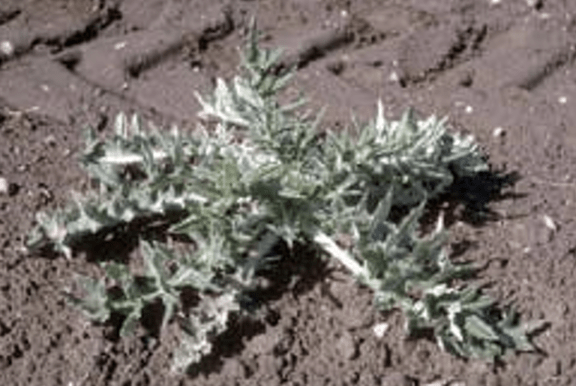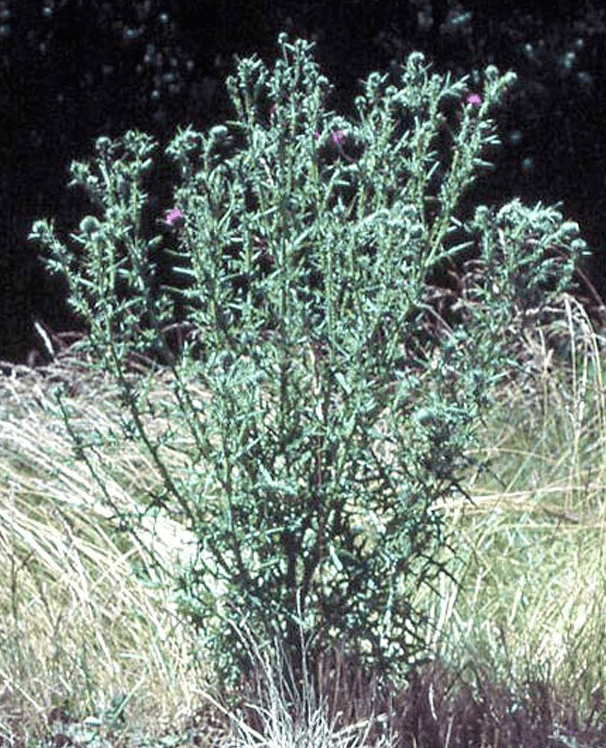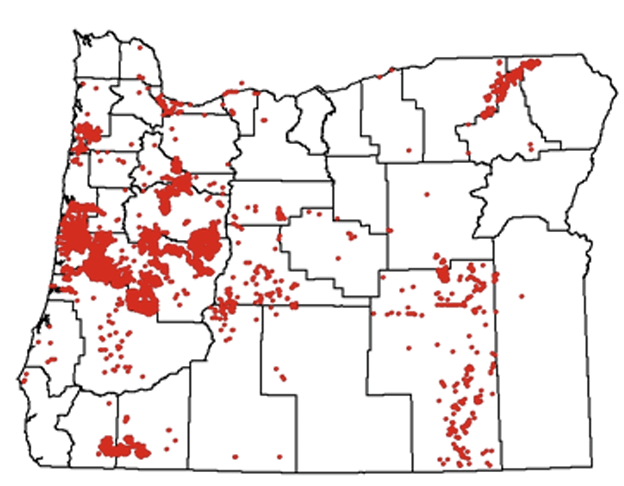Bull thistle is native to Europe, western Asia, and North Africa. It probably was introduced in eastern North America during colonial times, as a contaminant in seed or ship ballast. It is now the most widespread of the thistles in the United States (Figure 3) and is commonly found in disturbed areas such as roadsides and burned or newly logged forests. It invades a variety of habitats where it displaces native plants by outcompeting them for water, nutrients, and space. It does not grow well in shade. Bull thistle reproduces only by seed. Individual plants set seed before dying, and a single large plant can produce tens of thousands of seeds.
Description
Bull thistle is a biennial forb. In the juvenile phase (see Figure 1), the bull thistle develops a rosette with a fleshy taproot which can be as long as 28 inches. The second-year plant develops spiny wings from 1 to 5 feet tall with many spreading branches (Figure 2). Leaves are tipped with stout spines. The pinkish purple flowers, which appear from July through September, are 1.5 to 2 inches wide and are usually solitary. Seeds are dispersed by the wind and may remain viable in the soil for 10 years.
Management options
Biological, chemical, and mechanical methods are available for managing bull thistle. For this reason, it’s best to use an integrated weed management plan, including tactics to prevent the spread of bull thistle outside infested areas.
Biological control
The bull thistle seedhead gall fly has been released as a biocontrol agent. The larvae feed on developing seeds in the flower heads and decrease seed production. A crown weevil, a seedhead weevil, and a flower fly also are established in Oregon. However, biocontrol is considered relatively ineffective.
Chemical control
Note: Before you apply herbicide on forest land, you must file a “notification of operations” with the Oregon Department of Forestry at least 15 days in advance. The following information about herbicides is only a brief summary; consult your local Extension agent or Oregon Department of Agriculture representative for specific recommendations for your situation. Read and follow the herbicide label carefully.
- 2,4-D ester directed spray at 2 to 4 lb per acre applied 10 to 14 days before bolting of flowering stems.
- Dicamba (labeled for forestry applications) at 1 lb per acre is effective earlier in spring than 2,4-D. Or, 0.25 lb per acre dicamba mixed with 2,4-D at 0.5 lb per acre is very effective for spring spraying.
- Glyphosate as a directed spray is also effective.
Any herbicide treatment program should rotate among chemicals to prevent developing herbicide-resistant strains of the weed.
For more detailed information on chemical control, refer to the current edition of the PNW Weed Management Handbook and to Herbicide-resistant Weeds and Their Management, PNW 437. Both are available from OSU Extension.
Mechanical control
Cultivating, mowing, or hand-pulling just before flowering can reduce infestations. Cut flower heads can still develop viable seeds, so bag them to prevent seed from dispersing. Grubbing first-year rosettes 1 to 2 inches below the ground is sufficient to prevent resprouting. Burning is not effective.
Grazing
Bull thistle’s sharp spines deter livestock and wildlife from grazing them.
For more information
Weedmapper, a collaborative project of Oregon Department of Agriculture, Oregon State University, U.S. Bureau of Land Management, and U.S. Forest Service.
Oregon Department of Agriculture Oregon Noxious Weed Profiles
Use pesticides safely!
- Wear protective clothing and safety devices as recommended on the label. Bathe or shower after each use.
- Read the pesticide label—even if you’ve used the pesticide before. Follow closely the instructions on the label (and any other directions you have).
- Be cautious when you apply pesticides. Know your legal responsibility as a pesticide applicator. You may be liable for injury or damage resulting from pesticide use.


